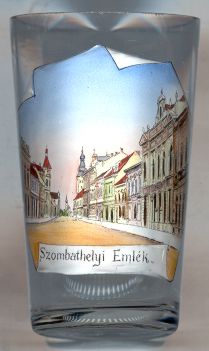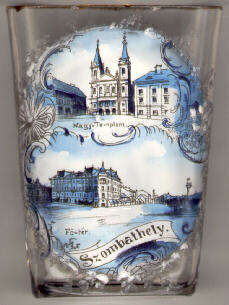

|
| MAGYARORSZÁG | HUNGARY |
| megye: Vas |
 Szombathely is situated on a place which had been an important trading place
already in the Stone Age. The Amber Road connecting the Baltic Sea with Italy also
passed through here. The Romans founded the predecessor of today's town in 43 AD,
named Colonia Claudia Savaria after Emperor Claudius. In 107 AD the town
became the capital of the Roman province of Pannonia superior. In 193 AD
Lucius Septimius Severus was elected Roman emperor here. In 316 AD Saint Martin of Tours
was born in Savaria. Until the 5th century Savaria had about 30,000 inhabitants
but an earthquake destroyed the town and the name of the place disappeared from all
known chronicles for centuries. Emperor Charles the Great (Charlemagne, 742–814) brought the town
under Frankonian rule. The German name Steinamanger probably refers
to the deserted state of the place at that time. The Hungarian name (Szombathely = Saturday place)
refers to the weekend fairs well-known during the Middle Ages. From the 13th century
onwards the place belonged to the bishops of Győr. It became the seat of a bishop in
1777 by decree of Maria Theresia of Austria, Queen of Hungary. The first bishop of
Szombathely, János Szily, initiated the rapid development of the town to a residence.
Szombathely is the seat of Vas county.
Szombathely is situated on a place which had been an important trading place
already in the Stone Age. The Amber Road connecting the Baltic Sea with Italy also
passed through here. The Romans founded the predecessor of today's town in 43 AD,
named Colonia Claudia Savaria after Emperor Claudius. In 107 AD the town
became the capital of the Roman province of Pannonia superior. In 193 AD
Lucius Septimius Severus was elected Roman emperor here. In 316 AD Saint Martin of Tours
was born in Savaria. Until the 5th century Savaria had about 30,000 inhabitants
but an earthquake destroyed the town and the name of the place disappeared from all
known chronicles for centuries. Emperor Charles the Great (Charlemagne, 742–814) brought the town
under Frankonian rule. The German name Steinamanger probably refers
to the deserted state of the place at that time. The Hungarian name (Szombathely = Saturday place)
refers to the weekend fairs well-known during the Middle Ages. From the 13th century
onwards the place belonged to the bishops of Győr. It became the seat of a bishop in
1777 by decree of Maria Theresia of Austria, Queen of Hungary. The first bishop of
Szombathely, János Szily, initiated the rapid development of the town to a residence.
Szombathely is the seat of Vas county.

The  Cathedral [left, no. 363: top] of Szombathely most likely
stands on the place of the forum of Savaria. The church was planned by the architect
Melchior Hefele who worked on it between 1791 and 1797, the year of his death. The
church was completed in 1814. The spires were added later. Heavy air rades during
World War II destroyed the interior of the church which was reconstructed after the war.
Cathedral [left, no. 363: top] of Szombathely most likely
stands on the place of the forum of Savaria. The church was planned by the architect
Melchior Hefele who worked on it between 1791 and 1797, the year of his death. The
church was completed in 1814. The spires were added later. Heavy air rades during
World War II destroyed the interior of the church which was reconstructed after the war.
The  Bishop's Palace [left, no. 363: top left] and the
Bishop's Palace [left, no. 363: top left] and the  Priests' Seminary [left, no. 363: top right] also were built by Melchior Hefele in 1777–1783.
Priests' Seminary [left, no. 363: top right] also were built by Melchior Hefele in 1777–1783.
The lower part of the picture on glass no. 363 [left] shows
 Fő tér, the main square of Szombathely.
Fő tér, the main square of Szombathely.
![[scale]](lineal.jpg)